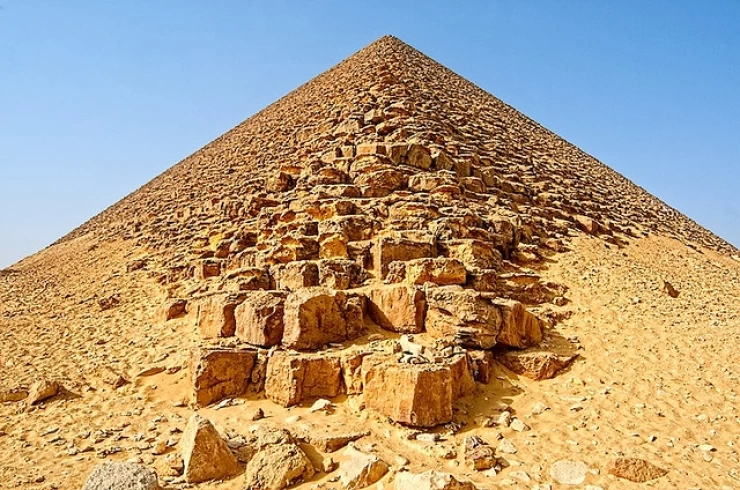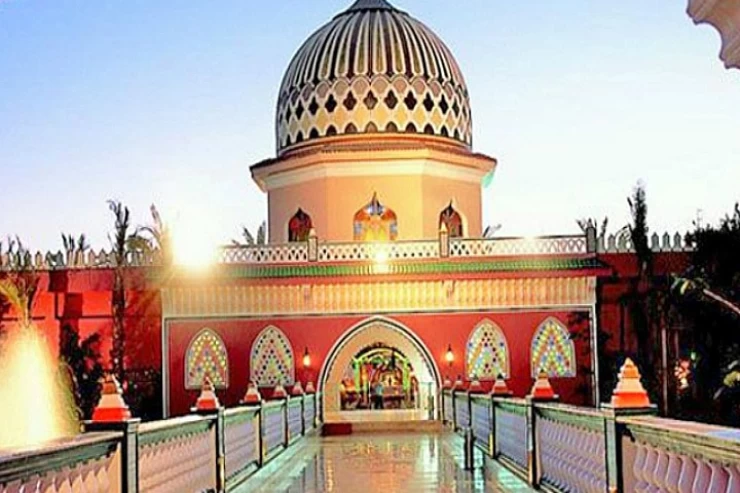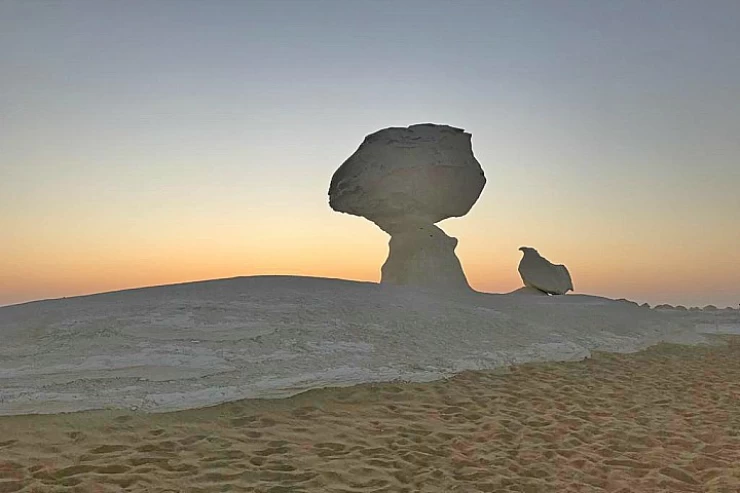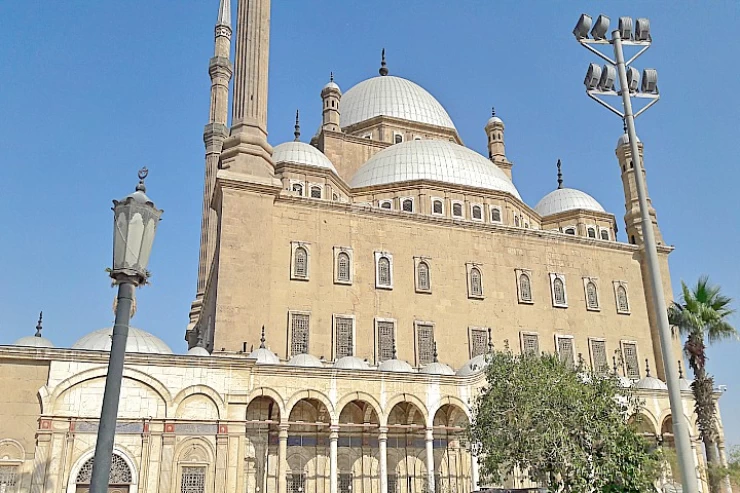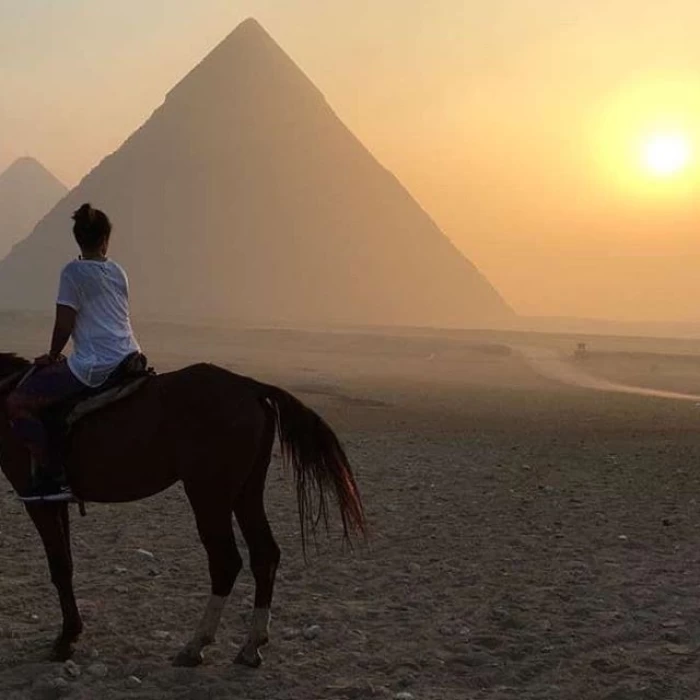
Egypt in History
Stone Age in Egypt was approximately 30,000 BC.
There are many pre-dynastic eras, and they are settlements, most of which were concentrated in the delta where the Nile River silt accumulates. It was also concentrated in Wadi Halfa after that, and at that time they relied on fish as a main food in their lives, and many civilizations came to the land of Egypt, such as the Sebilian, Qadani, and Harifian civilizations.
- Predynastic era (4400-3000 B.C.)
- This era contains some somewhat early civilizations, such as the Badari and Naqada civilizations, which are considered civilizations that paved the way for the beginning of the Pharaonic civilization, as they excelled in the pottery industry and developed some features of hieroglyphic writing.
2- The Old Kingdom (3000- 2686 B.C.)
It is divided into several periods, including periods that began with Menes Narmer, who is considered the first king in the history of Egypt. This era extends from King Menes until the Sixth Dynasty, and many kings came, such as King Zoser in the Third Dynasty, who built the Step Pyramid, and the kings who built the three pyramids in the Fourth Dynasty. After that, the Fifth Dynasty began, which was the first to worship the sun god Ra, which ended with King Unas, the writer of the Pyramid Texts, until the period of the last dynasty, in which the state began to weaken. Among its most famous kings was King Pepi II. Finally, Egypt went through a transitional period until the Middle Kingdom began during the reign of the Eleventh Dynasty.
The Middle Kingdom (2030-1650 B.C.)
This era began with King Intef the Great, who considered himself Horus, and was followed by King Mentuhotep I, who entered into a conflict with Intef the Great, and the wars between them continued for long periods until the last conflict during the reign of Mentuhotep II. Thus, the Twelfth Dynasty defeated the Eleventh Dynasty until his minister Amenemhat I came after that and became the first king of the Twelfth Dynasty, and Egypt continued to prosper and grow and passed through kings such as Senusret I and II until they reached the last king of the Old Kingdom, King Amenemhat III. Thus, the Middle Kingdom era ended, and the Second Intermediate Period came, which ended with Ahmose expelling the Hyksos and the beginning of a new era until the New Kingdom began as one of the greatest Pharaonic periods in history.
The modern kigdom (1570-1070 B.C.)
This era is one of the best eras in history. It began with the liberation of Egypt at the hands of Ahmose, and among many kings who left a great pharaonic legacy, such as the great Hatshepsut, followed by Thutmose III, then Amenhotep III and IV, until the Eighteenth Dynasty, and its most famous kings are the golden king Tutankhamun and Horemheb, until King Ramses I, founder of the Nineteenth Dynasty. After him came many kings, such as Seti I and II, Ramses II, owner of the Abu Simbel Temple, and Ramses III as well, who is considered the last great king in the modern state.
pre-greek era
At the end of the glorious era of the pharaohs, especially during the reign of King Ahmose II, when Cambyses asked him to marry his daughter, Ahmose refused and tried to enter Egypt, but before he arrived, Ahmose II died, and his son, King Psamtik III, entered the war in his place, but he lost and occupied Egypt for a long time, and Egypt remained under Persian rule.
Greek Period (Ptolemaic) 332–30 BC
In 333 BC, Alexander the Great was able to defeat the Persians and expel them from Egypt. Then Alexander built the city that has the same name as him, which is Alexandria, until Alexander died and was followed by the Ptolemies, who built many places such as the Temple of Philae in Aswan and the ancient Library of Alexandria, which was the destination of all scholars from all over the world.
This was before it was burned during the reign of Julius Caesar, as they say, but it is not certain. Egypt remained in the era of the Ptolemies until the naval Battle of Actium and the end of the Hellenistic period, and Egypt became a Roman province
Roman and Byzantine era (30 BC–642 AD)
Egypt remained a Roman province, but all that mattered to the emperor at that time was to protect his borders from external danger and build the largest empire in history. However, with time, Christianity began to appear, especially in Egypt after its entry at the hands of Saint Mark. The Romans continued to kill Christians until Emperor Constantine made Christianity the official religion of the country. Egypt remained a Christian state until Islam entered Egypt. Islamic eras before the occupation
Islamic Egypt is divided into several eras. Its beginning was with the entry of Islam into Egypt at the hands of Amr ibn al-Aas. After that, Egypt went through many periods and major events.
- The most important eras were the Fatimid and Ayyubid eras, as Egypt lived in peace during these periods, and they were interested in building mosques, such as Al-Azhar Mosque in the Fatimid era and the Citadel of Saladin in the Ayyubid era.
- There were many constructions during the Mamluk era, the most important of which was the opening of the Suez Canal, Muhammad’s control over the surrounding area, and his attempt to build the Egyptian Museum to protect antiquities from theft, and much more, until the Mamluk period began.
3. the Islamic era remained this way until the British entered Egypt in the twentieth century.
Egypt under foreign occupation
Egypt in the twentieth century with the occupation of the British into Egypt. Egypt continued to fight for years and carried out the 1919 revolution led by Mustafa Kamel. Many countries entered Egypt, but they were unable to win and they all left Egypt, like the French and the British, until the last victory in 1973 AD, and Egypt became completely independent.
New Cairo so far
After the assassination of President Sadat and the beginning of a new era with President Mubarak, who ruled Egypt for 30 years until the Egyptian people revolted and removed him from power, and the beginning of darkness that did not last long until President Sisi took power and fought the Brotherhood for many years and ended any danger as the Egyptians proved that they are capable of rising up no matter what the crises are, and this has been the case since the dawn of history.
Egypt under foreign occupation
Egypt began in the twentieth century with the entry of the British into Egypt and they continued to fight the Egyptians for years and carried out the 1919 revolution led by leader Mustafa Kamel and many countries entered Egypt but they were unable to win and they all left Egypt like the French and the British until the last victory in 1973 AD and Egypt became completely independent.
New Egypt
After President Sadat and the beginning of a new era with President Mubarak, who ruled Egypt for 30 years until the Egyptian people revolted and removed him from power, and the beginning of darkness that did not last long until President Sisi ruled and fought the Brotherhood for many years and ended any danger as the Egyptians proved that they are capable of rising up no matter what the crises are, and this has been the case since the dawn of history.
The ancient history that can be perceived from the Pharaohs has to be one of the greatest historical civilizations ever. Its events’ timeline is well over five thousand years, and many aspects of the world, such as art, architecture, culture, and even religion, have their bases in Egypt. The records of the land of Egypt are interesting in that they contain histories of empires that were built and then perished, histories of great kings and queens, and outstanding places and structures that even today, in modern societies, can only marvel at. Egypt’s history is undoubtedly dominated by a vibrant narrative of struggle, hope, and ingenuity of the people portrayed, from the making of the pyramids to the currents of the Nile.
The Ancient Kingdoms of Egypt (c. 3100 BC–332 BC)
1. Pre-Dynastic Period (Before 3100 BC)
The elements of history written of Egypt are dated around 3100 BC, but if one avails of its importance in terms of history, it dates back even to the pre-dynastic era, when there was the emergence of small agricultural settlements along the Nile. By this time, the early residents of Egypt were busy establishing forms of agriculture as well as animal husbandry, pottery making, and the making of crude tools. These settlements served as the foundation of the elaborate systems of culture and society that were to come.
2. The Unification and Early Dynastic Period (c. 3100–2686 BC)
King Narmer, often referred to as Menes was responsible for the unification of Upper and Lower Egypt, which signified the onset of ancient Egyptian civilization. He is considered to be the first pharaoh of Egypt and founded the nation’s first dynasty. This unifying act was essential since it created the nucleus around which the centralized monarchy of Egypt, which was the prevailing system of government for almost three thousand years, would revolve.
Towards the tail end of the Early Dynastic, the very first steps in the construction of monumental architecture began, and hieroglyphs were mastered. It was in this period that the rulers were expected to fulfill the role of the king and also that of a god. This idea existed for many years and was a fundamental one in Egypt.
3. The Old Kingdom (c. 2686–2181 BC)
The divine rulers, who were the Pharaohs in the earthly realm, tamed every resource and manpower to erect huge structures such as the Great Pyramid of Khufu and the Sphinx.
The Old Kingdom period displayed a clear and consistent administrative hierarchy and even a large-scale institutional support system that controlled the resources, agricultural production, and the temples of the state. However, in the latter years of this era, the dominant position of the central authority began to diminish, ushering in an era of chaos and fragmentation.
4. The Middle Kingdom (c. 2055–1650 BC)
Following the tumultuous First Intermediate Period referred to, Egypt returned to political stability and strong rulers in its Middle Kingdom. There is a revival in this period in the fields of art, literature, and monumental building works. Pharaohs such as Mentuhotep 11 and Senusret 111 were responsible for extending Egypt’s boundaries southward into Nubia as well as promoting relations with other countries through trade.
The Middle Kingdom is usually regarded as the classical period of ancient Egypt, filled with relative calm and wealth. The authorities emphasized the development of construction and the growth of the economy of Egypt. In spite of such achievements, the internal conflicts and external challenges finally caused the disintegration of the Middle Kingdom, making way for another period of darkness and despair.
5. The New Kingdom (c. 1550–1070 BC)
The new kingdom constitutes, also from a chronological point of view, the culminating era of ancient Egyptian civilization. It was during this period that Egypt was transformed into a full-fledged empire under rulers such as Thutmose III, Hatusu, and Rameses II, who through wars and conquests, or rather political strategies, expanded Egypt's borders. He also added great temples during this period, such as those at Karnak, Luxor, and Abu Simbel, many of which still exist today.
Il nuovo regno era un’epoca che riformò anche la religione in notevoli modi, come il periodo di regno del faraone Akhenaten, which introduced a period of continuous fight in worshipping a single god—Aten, the disk of the sun. His was, however, an unpopular and a very brief rule, for there were leaders after him who brought back the old ways of worship in Egypt, which was worshiping none but many gods.
But then, power aside, Egypt was not immune to the laws of history. By the close of the New Kingdom, this state institution in question was already wobbly, and there was a gradual abatement of its activities.
1. The Ptolemaic Dynasty (332–30 BC)
For many centuries, the old state of Egypt thrived free until that point in time, which altered when the rule of Alexander the Great started in the year 332 BC. It was also during those years that Alexandria became the center of Greek civilization and education, with the noted Library of Alexandria and the Lighthouse, which is now one of the Seven Wonders of the Ancient World.
Until the end of the dynasty, the traditions of Egypt were largely maintained, even though the rulers were Hellenistic kings. The last ruler of this dynasty, Cleopatra VII, was known to have opposed the domination of Rome by trying to establish relations with Julius Caesar and Mark Antony. However, after her loss at the Battle of Actium in 31 BC, Egypt fell into the Roman Empire.
Under the control of the Romans, Egypt was considered one of the most valuable provinces of the empire, primarily because it was rich and produced plenty of crops, particularly grains. The Romans maintained several of the practices of the Ptolemaic kings; however, Egypt was administered as a colony of the empire. The establishment of Christianity in Egypt started during the Roman times, and it was in the 4th century A.D. that Egypt began to develop into a significant early center of Christianity.
The phase change from the Roman to the Byzantine Empire that occurred in 395 AD marked the slow deterioration of Egypt’s economic well-being, but Egypt was still geographically and religiously active. It was also in this time period that the popular Coptic Church was born, which incorporated aspects of Christianity with ancient Egyptian beliefs.
The Egyptian territories fell to the Army of Islam in the year 642 AD. This marked the commencement of the Islamic Era in Egypt. As Cairo, a city created by the Fatimids in 969 AD, grew prominent, it was clear that Egypt was going to become one of the most pivotal countries in the Islamic world. After most of the Egyptian lands were conquered, Egypt witnessed great prosperity in learning, trade, and the arts.
The Fatimids, Ayyubids, and Mamluks
The capital of Egypt was established, and the famous Al-Azhar University was built during the reign of the Fatimid Dynasty which ruled over Egypt. With the waning of the Fatimid era, Egypt was captured for a brief period by the fact that Saladin, protector of the territories, including Egypt himself, later founded the Ayyubid dynasty, whose main task was fighting against the Crusaders.
Later came the Mamluks, who were a military caste and who ruled over Egypt for several eras. They built a number of the most beautiful structures in the city, including mosques, schools, and fortifications, in the Mamluk period. Egypt was, at least at the stage when it was defeated, a rather big country with advanced development before it was conquered by the Ottoman Empire.
Egypt in the Modern Era (1517–Present)
1. Ottoman and British Rule
With the Ottoman Empire's conquest in 1517, Egypt was annexed as part of the empire for nearly four hundred years and had remained so bound. That is primarily due to its geopolitical possibilities; it was invaded several times by European powers, and in 1798 Napoleon Bonaparte managed to invade Egypt for a short period. After the French lost in this region, Egypt was ruled by Muhammad Ali Pasha, who was on modern Egypt’s compass. He reformed agriculture, industry, and the military; these transformations served as the waking up of the modern state of Egypt.
In the late nineteenth century, Egypt acquired the status of a British protectorate, which lasted until ’52, the year Egypt resumed control after a revolution led by Gamal Abdel Nasser. It was Nasser who became one of the most powerful figures within the Arab sphere of influence, propagating pan-Arabism and earlier nationalizing the Suez Canal in 1956.







